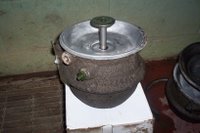 The C2 Freightliner school Bus comes with an Air Management Unit that houses all the necessary valves to run the air system. It's located in front of the drive axle, the valves are accessible once the mounting bar is removed. The brake switch, double check valve and park brake switch are a few of the valves in this unit.
The C2 Freightliner school Bus comes with an Air Management Unit that houses all the necessary valves to run the air system. It's located in front of the drive axle, the valves are accessible once the mounting bar is removed. The brake switch, double check valve and park brake switch are a few of the valves in this unit. We experienced a problem recently with the park brakes not releasing and found the park brake switch was at fault. When the park brake valve is pushed in, it sends an air signal to the switch which in turn sends a signal back to the bulkhead module indicating that the operator wants to release the spring brakes.
We experienced a problem recently with the park brakes not releasing and found the park brake switch was at fault. When the park brake valve is pushed in, it sends an air signal to the switch which in turn sends a signal back to the bulkhead module indicating that the operator wants to release the spring brakes.If this switch is faulty you cannot release the spring brakes until the switch is replaced. One way to check the operation of the park brake switch is to check the park brake indicator on the dash panel, it should be illuminated with brakes on. This will tell you that the electrical circuit has continuity.
 This chassis is a 2006, newer models have the AMU located behind the transmission. It's easier once you remove the mounting bar to flip the whole section of valves over 180 degrees for better access.
This chassis is a 2006, newer models have the AMU located behind the transmission. It's easier once you remove the mounting bar to flip the whole section of valves over 180 degrees for better access.The locking clip securing each module has to be inserted properly to seal the mating surfaces and fastens the whole assembly together.It helps to have someone to push the valves together while inserting the locking clip. The rubber gaskets in between each valve have to be in the right slots as well.





